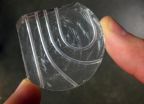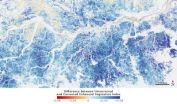(Press-News.org) The potential is there for bacteria and other microbes to be genetically engineered to perform a cornucopia of valuable goods and services, from the production of safer, more effective medicines and clean, green, sustainable fuels, to the clean-up and restoration of our air, water and land. Cells from eukaryotic organisms can also be modified for research or to fight disease. To achieve these and other worthy goals, the ability to precisely edit the instructions contained within a target's genome is a must. A powerful new tool for genome editing and gene regulation has emerged in the form of a family of enzymes known as Cas9, which plays a critical role in the bacterial immune system. Cas9 should become an even more valuable tool with the creation of the first detailed picture of its three-dimensional shape by researchers with the Lawrence Berkeley National Laboratory (Berkeley Lab) and the University of California (UC) Berkeley.
Biochemist Jennifer Doudna and biophysicist Eva Nogales, both of whom hold appointments with Berkeley Lab, UC Berkeley, and the Howard Hughes Medical Institute (HHMI), led an international collaboration that used x-ray crystallography to produce 2.6 and 2.2 angstrom (Å) resolution crystal structure images of two major types of Cas9 enzymes. The collaboration then used single-particle electron microscopy to reveal how Cas9 partners with its guide RNA to interact with target DNA. The results point the way to the rational design of new and improved versions of Cas9 enzymes for basic research and genetic engineering.
"The combination of x-ray protein crystallography and electron microscopy single-particle analysis showed us something that was not anticipated," says Nogales. "The Cas9 protein, on its own, exists in an inactive state, but upon binding to the guide RNA, the Cas9 protein undergoes a radical change in its three-dimensional structure that enables it to engage with the target DNA."
"Because we now have high-resolution structures of the two major types of Cas9 proteins, we can start to see how this family of bacterial enzymes has evolved," Doudna says. "We see that the two structures are quite different from each other outside of their catalytic domains, suggesting an interesting structural plasticity that could explain how Cas9 is able to use different kinds of guide RNAs. Also, the differences in the two structures suggest that it may be possible to engineer smaller Cas9 variants and still retain function, an important goal for some genome engineering applications."
Doudna and Nogales are the corresponding authors, along with Martin Jinek of the University of Zurich, of a paper in Science that describes this research. The paper is titled "Structures of Cas9 endonucleases reveal RNA-mediated conformational activation." Co-authors are Fuguo Jiang, David Taylor, Samuel Sternberg, Emine Kaya, Enbo Ma, Carolin Anders, Michael Hauer, Kaihong Zhou, Steven Lin, Mattias Kaplan, Anthony Iavarone and Emmanuelle Charpentier.
Bacteria face a never-ending onslaught from viruses and invading strands of nucleic acid known as plasmids. To survive, they deploy a variety of defense mechanisms, including an adaptive-type nucleic acid-based immune system that revolves around a genetic element known as CRISPR, which stands for Clustered Regularly Interspaced Short Palindromic Repeats. Through the combination of CRISPR and squads of CRISPR-associated or "Cas" proteins, microbes are able to utilize small customized RNA molecules as guides to target and silence critical portions of an invader's genetic message and also to acquire immunity from similar invasions in the future.
Cas9 is a family of RNA-guided bacterial endonucleases employed by Type II CRISPR systems to recognize and cleave double-stranded DNA at site-specific sequences. Genetic engineers have begun harnessing Cas9 for genome editing and gene regulation in many eukaryotic organisms. However, despite the successes to date, the technology has yet to reach its full potential because until now the structural basis for guide RNA recognition and DNA targeting by Cas9 has been unknown.
Doudna, Nogales and their collaborators addressed this knowledge deficit by first solving the three-dimensional crystal structures of two Cas9 proteins, representing large and small versions, from Streptococcus pyogenes (SpyCas) and Actinomyces naeslundii (AnaCas9) respectively. Using protein crystallography beamlines at Berkeley Lab's Advanced Light Source and the Paul Scherer Institute's Swiss Light Source, the collaboration discovered that despite significant differences outside of their catalytic domains, all members of the Cas9 family share the same structural core. The high resolution images showed this core to feature a clam-shaped architecture with two major lobes - a nuclease domain lobe and an alpha-helical lobe. Both lobes contained conserved clefts that become functional in nucleic acid binding.
"Our understanding of Cas9's structure was not complete with only the x-ray data because the protein in the crystals had been trapped in a state without its associated guide RNA," says Sam Sternberg, a member of Doudna's research group and a co-author of the Science paper. "Understanding how RNA-guided Cas9 targets matching DNA sequences for genome engineering and how this reaction and its specificity might be improved required an understanding of how the shape of Cas9 changes when it interacts with guide RNA, and when a matching DNA target sequence is bound."
The collaboration employed negative-staining electron microscopy to visualize the Cas9 protein bound to either guide RNA, or both RNA and target DNA. The structures revealed that the guide RNA binding structurally activates Cas9 by creating a channel between the two main lobes of the protein that functions as the DNA-binding interface.
"Our single particle electron microscopy analysis reveals the importance of guide-RNA for the conversion of Cas9 into a structurally-activated state," says David Taylor, a joint member of Doudna's and Nogales's research groups and another co-author of the Science paper. "The results underline that, in addition to sequence complementarity, other features of the guide-RNA must be considered when employing this technology."
INFORMATION:
This research was primarily funded by HHMI, the Bill and Melinda Gates Foundation and the National Science Foundation.
Lawrence Berkeley National Laboratory addresses the world's most urgent scientific challenges by advancing sustainable energy, protecting human health, creating new materials, and revealing the origin and fate of the universe. Founded in 1931, Berkeley Lab's scientific expertise has been recognized with 13 Nobel prizes. The University of California manages Berkeley Lab for the U.S. Department of Energy's Office of Science. For more, visit http://www.lbl.gov.
The Advanced Light Source is a third-generation synchrotron light source producing light in the x-ray region of the spectrum that is a billion times brighter than the sun. A DOE national user facility, the ALS attracts scientists from around the world and supports its users in doing outstanding science in a safe environment. For more information visit www-als.lbl.gov.
New insight into an emerging genome-editing tool
Berkeley researchers show expanded role for guide RNA in Cas9 interactions with DNA
2014-02-06
ELSE PRESS RELEASES FROM THIS DATE:
Credit card-sized device could analyze biopsy, help diagnose pancreatic cancer in minutes
2014-02-06
Pancreatic cancer is a particularly devastating disease. At least 94 percent of patients will die within five years, and in 2013 it was ranked as one of the top 10 deadliest cancers.
Routine screenings for breast, colon and lung cancers have improved treatment and outcomes for patients with these diseases, largely because the cancer can be detected early. But because little is known about how pancreatic cancer behaves, patients often receive a diagnosis when it's already too late.
University of Washington scientists and engineers are developing a low-cost device that ...
UI researchers evaluate best weather forecasting models
2014-02-06
Two University of Iowa researchers recently tested the ability of the world's most advanced weather forecasting models to predict the Sept. 9-16, 2013 extreme rainfall that caused severe flooding in Boulder, Colo.
The results, published in the December 2013 issue of the journal Geophysical Research Letters, indicated the forecasting models generally performed well, but also left room for improvement.
David Lavers and Gabriele Villarini, researchers at IIHR—Hydroscience and Engineering, a world-renowned UI research facility, evaluated rainfall forecasts from eight different ...
Nanoparticle pinpoints blood vessel plaques
2014-02-06
A team of researchers, led by scientists at Case Western Reserve University, has developed a multifunctional nanoparticle that enables magnetic resonance imaging (MRI) to pinpoint blood vessel plaques caused by atherosclerosis. The technology is a step toward creating a non-invasive method of identifying plaques vulnerable to rupture–the cause of heart attack and stroke—in time for treatment.
Currently, doctors can identify only blood vessels that are narrowing due to plaque accumulation. A doctor makes an incision and slips a catheter inside a blood vessel in the arm, ...
Loose coupling between calcium channels and sensors
2014-02-06
This news release is available in German. Information transmission at the synapse between neurons is a highly complex, but at the same time very fast, series of events. When a voltage change, the so-called action potential, reaches the synaptic terminal in the presynaptic neuron, calcium flows through voltage-gated calcium channels into the presynaptic neuron. This influx leads to a rise in the intracellular calcium concentration. Calcium then binds to a calcium sensor in the presynaptic terminal, which in turn triggers the release of vesicles containing neurotransmitters ...
US lead in science and technology shrinking
2014-02-06
The United States' (U.S.) predominance in science and technology (S&T) eroded further during the last decade, as several Asian nations--particularly China and South Korea--rapidly increased their innovation capacities. According to a report released today by the National Science Board (NSB), the policy making body of the National Science Foundation (NSF) and an advisor to the President and Congress, the major Asian economies, taken together, now perform a larger share of global R&D than the U.S., and China performs nearly as much of the world's high-tech manufacturing as ...
Prickly protein
2014-02-06
A genetic mechanism that controls the production of a large spike-like protein on the surface of Staphylococcus aureus (staph) bacteria alters the ability of the bacteria to form clumps and to cause disease, according to a new University of Iowa study.
The new study is the first to link this genetic mechanism to the production of the giant surface protein and to clumping behavior in bacteria. It is also the first time that clumping behavior has been associated with endocarditis, a serious infection of heart valves that kills 20,000 Americans each year. The findings were ...
NASA study points to infrared-herring in apparent Amazon green-up
2014-02-06
For the past eight years, scientists have been working to make sense of why some satellite data seemed to show the Amazon rain forest "greening-up" during the region's dry season each year from June to October. The green-up indicated productive, thriving vegetation in spite of limited rainfall.
Now, a new NASA study published today in the journal Nature shows that the appearance of canopy greening is not caused by a biophysical change in Amazon forests, but instead by a combination of shadowing within the canopy and the way that satellite sensors observe the Amazon during ...
Valentine's Day advice: Don't let rocky past relations with parents spoil your romance
2014-02-06
University of Alberta relationship researcher Matt Johnson has some Valentine's Day advice for anybody who's had rocky relations with their parents while growing up: don't ...
Falcon feathers pop-up during dive
2014-02-06
Similar to wings and fins with self-adaptive flaps, the feathers on a diving peregrine falcon's feathers may pop-up during high speed dives, according to a study published in PLOS ONE on February 5, 2014 by Benjamin Ponitz from the Institute of Mechanics ...
New, high-tech prosthetics and orthotics offer active life-style for users
2014-02-06
TAMPA, Fla. (Feb. 5, 2014) – Thanks to advanced technologies, those who wear prosthetic and orthotic devices ...
LAST 30 PRESS RELEASES:
The impact of family dynamics on eating behaviour – how going home for Christmas can change how you eat
Tracing the quick synthesis of an industrially important catalyst
New software sheds light on cancer’s hidden genetic networks
UT Health San Antonio awarded $3 million in CPRIT grants to bolster cancer research and prevention efforts in South Texas
Third symposium spotlights global challenge of new contaminants in China’s fight against pollution
From straw to soil harmony: International team reveals how biochar supercharges carbon-smart farming
Myeloma: How AI is redrawing the map of cancer care
Manhattan E. Charurat, Ph.D., MHS invested as the Homer and Martha Gudelsky Distinguished Professor in Medicine at the University of Maryland School of Medicine
Insilico Medicine’s Pharma.AI Q4 Winter Launch Recap: Revolutionizing drug discovery with cutting-edge AI innovations, accelerating the path to pharmaceutical superintelligence
Nanoplastics have diet-dependent impacts on digestive system health
Brain neuron death occurs throughout life and increases with age, a natural human protein drug may halt neuron death in Alzheimer’s disease
SPIE and CLP announce the recipients of the 2025 Advanced Photonics Young Innovator Award
Lessons from the Caldor Fire’s Christmas Valley ‘Miracle’
Ant societies rose by trading individual protection for collective power
Research reveals how ancient viral DNA shapes early embryonic development
A molecular gatekeeper that controls protein synthesis
New ‘cloaking device’ concept to shield sensitive tech from magnetic fields
Researchers show impact of mountain building and climate change on alpine biodiversity
Study models the transition from Neanderthals to modern humans in Europe
University of Phoenix College of Doctoral Studies releases white paper on AI-driven skilling to reduce burnout and restore worker autonomy
AIs fail at the game of visual “telephone”
The levers for a sustainable food system
Potential changes in US homelessness by ending federal support for housing first programs
Vulnerability of large language models to prompt injection when providing medical advice
Researchers develop new system for high-energy-density, long-life, multi-electron transfer bromine-based flow batteries
Ending federal support for housing first programs could increase U.S. homelessness by 5% in one year, new JAMA study finds
New research uncovers molecular ‘safety switch’ shielding cancers from immune attack
Bacteria resisting viral infection can still sink carbon to ocean floor
Younger biological age may increase depression risk in older women during COVID-19
Bharat Innovates 2026 National Basecamp Showcases India’s Most Promising Deep-Tech Ventures
[Press-News.org] New insight into an emerging genome-editing toolBerkeley researchers show expanded role for guide RNA in Cas9 interactions with DNA






